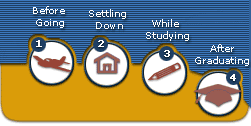|
Auto Insurance: The Basics
Most states in the U.S. require you to purchase auto insurance before you start driving. In these states, driving without auto insurance is illegal, and if you are in an accident or are stopped by the police without insurance, you will be heavily fined and may even go to jail. Check with your local Department of Motor Vehicles (DMV) about laws specific to your state. Even if you can legally drive without auto insurance, it is probably wise to obtain at least a basic package in order to avoid great costs incurred by an accident.
Some states are "no-fault" insurance states. If you live in one of these states, drivers must insure their vehicles and their auto insurance companies must pay for the damages no matter which party causes the accident.
In states that don't have "no fault" laws, whoever is responsible for causing an accident will be required to pay for the costs of the accident. Either the person at fault or that person's insurance company would make the payments.
- How Much Auto Insurance do I Need?
An auto insurance agent can best answer this question. However, here are some factors to consider:
- Liability Coverage
- Driving record/history of the person that will be covered by the insurance policy
- Primary use of the car (business or personal use)
- How far the car will be driven each day. For example, if you drive a lot, you may want to consider getting more insurance coverage because you have a higher chance of having an accident. The same holds true for a person who has a history of being involved in accidents.
Note: The more insurance coverage you require the higher your insurance cost will be.
This should give you an idea how much insurance coverage you need. In order to get the proper coverage, contact an auto insurance specialist.
Note: This additional coverage is often offered through credit cards, car manufacturers, and automobile club memberships. Therefore, if you have this type of coverage already, you won't need to include this in your auto insurance policy. There is no need to have double coverage.
What's Next?
Now that you know the types of coverage that are available, you may want to consider the following items when selecting the proper insurance coverage:
Deductible
The amount of money you must pay before the insurance companies will pay for damages. Taking higher deductibles will reduce your premiums, but you will have to pay more before the insurance coverage applies.
Note: Make sure you have the right amount of cash or liquid assets to pay the deductible.
Liability Limit
The maximum amount that your insurance company is required to pay for a liability claim. The higher your liability limit is, the higher your premiums will be.
Discounts
You may be elligible for various discounts on auto insurance policies that are available for such things as insuring multiple cars, taking driver training, using an anti-theft system, having a good driving record, and owning a car with anti-lock brakes. Also, some companies offer student discounts. This varies by state as well as by company.
Tips
- Claims
Try to avoid filing small claims. If you file several small claims, your insurance companies may consider you to be a bad risk and raise your premiums.
- Shopping for a Car
When shopping for a car, sports cars and luxury cars have higher premium rates. Thus, if you really need to drive a Mercedes or BMW, be prepared to pay substantially higher insurance rates.
|










